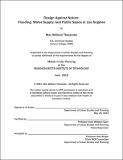Design against nature : flooding, water supply, and public space in Los Angeles
Author(s)
Thelander, Max William
DownloadFull printable version (23.39Mb)
Alternative title
Flooding, water supply, and public space in Los Angeles
Other Contributors
Massachusetts Institute of Technology. Dept. of Urban Studies and Planning.
Advisor
Anne Whiston Spirn.
Terms of use
Metadata
Show full item recordAbstract
Starting in the late 19th century, Southern California saw the first of several waves of explosive population growth that have resulted in today's mega-region. While many early settlers were attracted by the city's famous sunshine, the surging population exceeded locally-available water supplies early on. Los Angeles responded by building a vast system of aqueducts to appropriate waters from across the West. At the same time, Los Angeles faces the most severe flooding hazard of any major American city, due to the rare but extreme rainfalls that are intrinsic to its Mediterranean climate. Historically, the Los Angeles River had flowed freely across the basin, but soaring demand for land set the stage for battle between an unpredictable natural system and modernist engineering methods. The river was converted into infrastructure, a concrete channel designed to chute stormwater out to sea as quickly as possible. Since the mid-1980s, a movement to 'revitalize' the river has gained increasing momentum. The river is one of the few remaining open spaces in many parts of central LA, and could form the backbone of a regional trail network to rival the freeways, as well as making ecologically valuable habitat connections. However, much of this vision depends on reducing the need for river to convey the entire watershed's runoff. The 21st century will present California with greater water supply challenges, as well as the potential for more severe urban flooding. It is clear that the last century's approach of building mega-scale, single-purpose infrastructure cannot sufficiently meet future needs. What is needed now is a decentralized approach to stormwater, in which rain is captured where it falls. This approach holds the potential to reduce flooding (enabling revitalization of the main river channel), reduce dependence on imported water by recharging local aquifers, and reduce downstream water pollution, among other benefits. However, the widespread implementation of this concept will depend on the public taking a much more active role in managing their watershed.
Description
Thesis (M.C.P.)--Massachusetts Institute of Technology, Dept. of Urban Studies and Planning, 2012. This electronic version was submitted by the student author. The certified thesis is available in the Institute Archives and Special Collections. Cataloged from student submitted PDF version of thesis. Includes bibliographical references (p. 83-85).
Date issued
2012Department
Massachusetts Institute of Technology. Department of Urban Studies and PlanningPublisher
Massachusetts Institute of Technology
Keywords
Urban Studies and Planning.